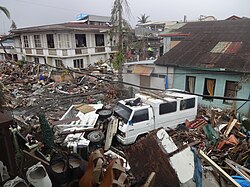Typhoon Haiyan
Typhoon Haiyan (or Super Typhoon Yolanda in the Philippines) is one of the strongest tropical cyclones in history. It formed on November 3, 2013, in the western Pacific Ocean. It began east-southeast of Pohnpei. The storm later hit the Philippines with extremely high winds and a strong storm surge. It has caused major damage in the Visayas. At least 6,241 people died in the storm. The director of Meteorology at Weather Underground, Jeff Masters, said this could be the strongest tropical system to reach land. [1] Haiyan's winds were near 195 miles an hour.
| Typhoon (JMA scale) | |
|---|---|
| Category 5 (Saffir–Simpson scale) | |
 Typhoon Haiyan at peak intensity, on November 7 | |
| Formed | November 3, 2013 |
| Dissipated | November 11, 2013 |
| Highest winds | 10-minute sustained: 230 km/h (145 mph) 1-minute sustained: 315 km/h (195 mph) |
| Lowest pressure | 895 mbar (hPa); 26.43 inHg (Estimated) |
| Fatalities | 6,241 confirmed, 1,785 missing |
| Damage | $1.5 billion (2013 USD) (Preliminary total) |
| Areas affected | |
| Part of the 2013 Pacific typhoon season | |
Typhoon Haiyan Media
Geographical images of Typhoon Haiyan (superimposed) and Hurricane Katrina (2005) in the Gulf of Mexico for size and cloud top temperature comparison
Weather radar reflectivity loop of Haiyan's landfall on Leyte Island. Tacloban was struck by the northern eyewall, the most powerful part of the storm; it obliterated much of the city.
An aerial view of Guiuan, the town where the typhoon made its first landfall
Destruction in Basey, Samar after the typhoon passed over the town
Related pages
References
- ↑ Mark Fischetti (12 November 2013). "Was Typhoon Haiyan a Record Storm?". Scientific American. Retrieved 22 January 2014.









